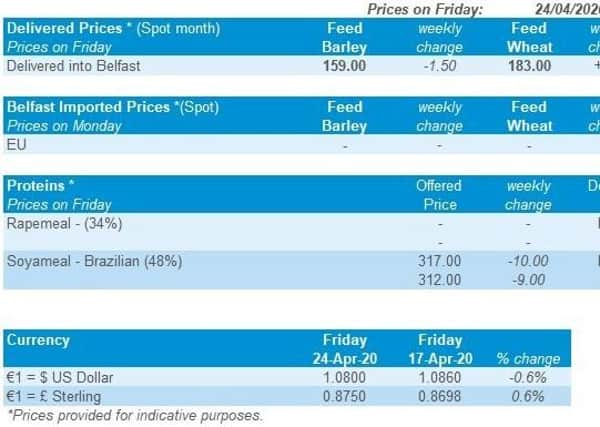Northern Ireland Weekly Market Report


Grains
Wheat
Eyes are still on the Black Sea where a lack of rainfall in Ukraine and parts of Southern Russia has provided support by reducing production estimates. But with rainfall forecast, support may fade if sufficient to replenish soil moisture.
Maize
In what is traditionally now a weather market, even a lack of rainfall in southern Brazil, while threatening yields, isn’t enough to outweigh the global economic slowdown and lack of ethanol demand.
Barley
Advertisement
Advertisement
A pressured maize market and likely reduced malt demand, combined with forecast rainfall in the UK and across the EU is continuing to add pressure for old and new crop barley.
Global Markets
Traditionally, this time of year leaves global markets at the mercy of the weather, especially for new crop production estimates.
From a maize perspective, there have been mounting dryness concerns for southern Brazilian maize production, where an already delayed crop is going through yield critical development stage. However, conditions in the main maize production state of Mato Grosso are faring better and unlikely to outweigh the reduced demand sentiment.
For wheat, all eyes have remained on the Black Sea, where dry conditions have led to downward Russian wheat production forecasts, as Southern Russian soil moisture remains at multi year lows. However, rainfall is forecast into the beginning of May for Ukraine and Russia, which could soften support. Rainfall forecasts across the EU and the UK are likely to address depleting soil moisture concerns for wheat and barley, potentially reducing new crop production concerns.
Advertisement
Advertisement
Global maize markets continue to be under pressure, as ethanol demand remains minimal and is likely to remain so for the foreseeable. US ethanol stocks rose once more to set a new record by 17 April at 27,689 thousand barrels. Although now increasing at a minimal rate, the increase in stocks highlights that production cuts have failed to outweigh the demand shock, with potentially further pressure for US maize.
With falling maize prices globally, the 10 day average price of importing maize into the EU has fallen below the €157.03/t threshold, where an import levy is imposed. With imported EU maize prices nearing a floor, there may be a temporary reprieve from the maize pressured wheat market.
UK focus
Old crop UK feed wheat futures (May-20) bounced back last week (£7.10/t from 17 April to 24 April) having reaching a contract record low of over £24/t below that of May-20 Paris milling wheat futures at the start of last week (20 April). However, the UK May-20 contract is now past the first notice date (24 April) and now may begin to lose its relevance as we move into May.
Additional support for UK feed wheat was provided last week as Paris milling wheat futures found support from potential increased export demand expectations, as Russian export restriction look likely to come into force in May.
Advertisement
Advertisement
However, with the discount to Paris milling wheat now narrowed and Black Sea export restrictions now potentially priced in, domestic wheat markets for now lack bullish factors. Especially as the forecast rains for this week will be a welcome sight for UK wheat and barley production outlooks.
Oilseeds
Rapeseed
Crop conditions remain a watch area in western Europe after dry weather, but rain is expected over the next fortnight and falling demand for veg oils is currently the larger influence on prices.
Soyabeans
Prices remain under pressure as the start of planting represents a first step towards another large US soyabean crop, at a time when demand is down.
Global Markets
Soyabean prices slid lower again last week following the start of planting in the US and a sharp fall in crude oil prices due to the continuing fallout from the coronavirus pandemic. Soyabean planting has started with favourable weather, and is a first step towards realising another large US crop.
Advertisement
Advertisement
US crude oil (WTI) futures nearby prices went negative for the first time in their history last week. Traders scrambled to sell May futures ahead of the contract’s last trading day due to a shortage of storage at the delivery point in Cushing. Crude oil stocks are rising as the coronavirus pandemic reduces demand. Nearby Brent crude oil futures, which are important for Europe, fell $6.64/barrel Friday-Friday to $21.44/barrel.
The nearby Malaysian palm oil futures contract fell to a nine month low last week. Lockdowns are reducing demand for transport fuels, including biodiesel made from palm oil. Also, more palm oil is usually used for communal meals during the holy month of Ramadan, which began on 23 April, but this is being curbed by coronavirus lockdowns.
China imported 13% fewer soyabeans in March than March 2019, after rain disrupted loading of ships in Brazil. However, news that China had booked 606Kt of US soyabeans last week for 2019/20 delivery added a positive note for Chicago soyabean futures towards the end of the week.
Rapeseed focus
EU-27 rapeseed production is expected to recover from last year’s drought by the EU Commission. Its first forecast for 2020/21 put the EU-27 crop at 16.7Mt vs 14.9Mt in 2019/20. A larger crop at a time when demand is being reduced would add more pressure to new crop rapeseed prices.
Advertisement
Advertisement
Recent dry weather has raised concerns but there is rain forecast for the next fortnight so it’s a case of watch and see. The EU’s crop condition report is due out later today and will be watched for insight into yield potential.
UK rapeseed prices for May delivery fell Friday-Friday, echoing declines in the Paris futures price. On Friday, UK rapeseed delivered in Nov was quoted at £ 330/t, £10.50/t above the price for May delivery.
Canadian planting intentions data has been delayed until 7 May due to the coronavirus pandemic.